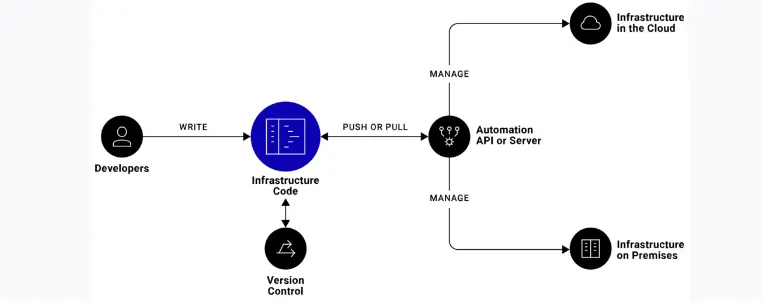Demystifying Infrastructure as Code (IaaC): A Comprehensive Technical Guide

Audio : Listen to This Blog.
Infrastructure as Code (IaaC) stands as a cornerstone in contemporary cloud computing, fundamentally altering the landscape of infrastructure provisioning, management, and scalability. It symbolizes a paradigmatic transition towards automated, repeatable, and scalable approaches within IT operations. In this exhaustive technical exposition, we explore Infrastructure as Code in-depth, delving into its nuanced concepts, multifaceted benefits, intricate implementation strategies, best practices, history, and future trajectories.
Understanding Infrastructure as Code (IaaC)
Infrastructure as Code (IaaC) represents a sophisticated software engineering solution methodology meticulously designed to streamline and automate the provisioning and management of infrastructure resources.
- At its core, IaaC relies on machine-readable definition files, meticulously crafted to encapsulate the intricacies of infrastructure configuration.
- By abstracting infrastructure elements into code, this approach enables developers and operations teams to transcend the limitations of manual intervention, empowering them to define, deploy, and manage infrastructure resources programmatically.
- Leveraging the power of code, organizations can achieve unprecedented efficiency, consistency, and scalability in their infrastructure operations, ushering in a new era of agility and innovation.
Developers and operations teams collaborate seamlessly online, leveraging version control systems to track changes, perform code reviews, and ensure the integrity of infrastructure configurations. Moreover, the programmable nature of IaaC empowers organizations to adopt a DevOps mindset, fostering collaboration, automation, and continuous improvement across the software development lifecycle. As organizations embrace IaaC, they unlock the potential to accelerate deployment cycles, minimize operational overhead, and deliver value to customers with unprecedented speed and efficiency.
Key Concepts of Infrastructure as Code (IaaC)

Source: Medium
At the core of IaaC lie vital concepts that shape its implementation and efficacy. From understanding the distinction between declarative and imperative paradigms to embracing idempotency and versioning, grasping these fundamental concepts is essential for unlocking the full potential of Infrastructure as Code.
Key Concepts of Infrastructure as Code (IaaC)
In Infrastructure as Code (IaaC), understanding the distinction between declarative and imperative paradigms is essential. Declarative IaaC focuses on specifying the desired state of the infrastructure without prescribing the exact steps to achieve it. Instead, it describes the result, leaving the implementation details to the IaaC tool. On the other hand, imperative IaaC provides explicit instructions on providing and configuring infrastructure resources, delineating each step in the process. Deciding between these approaches hinges on complexity, maintainability, and team preferences, each offering advantages and trade-offs.
Idempotency: Ensuring Consistency and Reliability
Idempotency is a cornerstone principle in Infrastructure as Code (IaaC), underpinning the reliability and predictability of infrastructure provisioning and management. At its core, idempotency ensures that executing the same code multiple times yields the same desired state, regardless of the initial state of the infrastructure. This consistency mitigates unintended side effects or discrepancies caused by repeated executions, fostering reliability and reproducibility in infrastructure deployments. By adhering to idempotent coding practices, organizations can minimize errors, streamline operations, and enhance the overall stability of their infrastructure environments.
Infrastructure as Versioned Code: Harnessing the Power of Version Control
Treating infrastructure configuration as code introduces the concept of versioning, enabling teams to track changes, collaborate effectively, and manage configuration drifts over time. Version control systems like Git play a pivotal role in managing infrastructure code, offering features such as branching, merging, and rollback capabilities. By creating and maintaining a centralized repository of infrastructure code, teams can gain visibility into changes, facilitate code reviews, and ensure auditability and compliance.
Additionally, versioned infrastructure code empowers teams to experiment with new configurations, revert to known working states, and implement changes confidently, fostering a culture of continuous improvement and innovation within the organization.
The Power of Events in IaaC Orchestration
In Infrastructure as Code (IaaC), events play a pivotal role in orchestrating the deployment and management of infrastructure resources. Events represent triggers or notifications that initiate actions or change workflows within the infrastructure deployment process. These events can range from manual interventions, such as user-initiated changes or approvals, to automated triggers created based on predefined conditions, such as resource scaling thresholds or configuration changes. Organizations can implement dynamic and responsive infrastructure management workflows by leveraging events, enabling automatic scaling, fault remediation, and real-time configuration updates.
Harnessing Environment in the IaaC Journey
In Infrastructure as Code (IaaC), the environment serves as distinct configurations or contexts within which infrastructure resources are provisioned, managed, and operated. Environment typically corresponds to the software development lifecycle stages: development, testing, staging, and production. Each environment may have unique configurations, resource allocations, and access controls tailored to its specific purpose and requirements. Organizations can ensure consistency, reproducibility, and isolation across diverse infrastructure deployments by defining and managing environments programmatically.
Benefits of Infrastructure as Code (IaaC)

Source: Veritis
In the era of cloud computing and DevOps, Infrastructure as Code (IaaC) stands as a cornerstone technology, offering many benefits to organizations striving for agility, scalability, and efficiency in their IT operations. By abstracting infrastructure configuration into code, IaaC enables automation, repeatability, and consistency in the provisioning and managing of infrastructure resources. This section delves into the myriad benefits Infrastructure as Code brings, ranging from automation and consistency to scalability and DevOps integration.
Maximizing Efficiency through Automation
IaaC revolutionizes infrastructure resource provisioning, configuration, and management through automation, drastically reducing manual intervention, human error, and time-to-market delays. Organizations can achieve unprecedented agility, scalability, and operational efficiency by automating repetitive tasks and workflows, empowering teams to focus on innovation and value-added activities.
Ensuring Unwavering Consistency
With IaaC, infrastructure configuration becomes codified, ensuring uniformity and consistency across diverse environments. By eliminating the possibility of configuration drift and maintaining identical setups across development, testing, and production environments, IaaC enhances application deployments’ reliability, repeatability, and predictability. This meticulous consistency fosters confidence in the integrity of infrastructure configurations, mitigating the risk of discrepancies and errors.
Unleashing Limitless Scalability
IaaC empowers organizations to scale infrastructure resources dynamically in response to fluctuating workload demands. Organizations can use automated scaling policies and cloud-native services such as auto-scaling groups to optimize resource utilization and cost efficiency while seamlessly accommodating spikes in traffic or processing requirements. This inherent scalability ensures that infrastructure resources align precisely with business needs, enabling organizations to scale effortlessly as they grow.
Bridging the Gap with DevOps Integration
Infrastructure as Code is a linchpin in DevOps practices, facilitating seamless collaboration and integration between development and operations teams. Organizations can embrace DevOps principles such as collaboration, automation, and continuous delivery by treating infrastructure as code, accelerating the software development lifecycle. IaaC enables organizations to achieve shorter development cycles, faster time-to-market, and enhanced agility in responding to customer needs and market demands through automated testing, deployment pipelines, and infrastructure provisioning.
Implementation Strategies for IaaC
Embarking on implementing Infrastructure as Code (IaaC) requires organizations to navigate a complex landscape of technical considerations, operational challenges, and organizational dynamics. From selecting the right tools and adopting modularization techniques to embracing testing and validation practices and integrating with CI/CD pipelines, implementing IaaC demands a strategic approach. This section explores critical implementation strategies that pave the way for the successful adoption of Infrastructure as Code.
Crafting the Perfect Toolkit
Selecting the optimal toolkit is paramount for a successful Infrastructure as Code (IaaC) implementation. Well-established IaaC tools such as Terraform, AWS CloudFormation, or Azure Resource Manager are pillars in this domain, offering robust capabilities for defining, provisioning, and managing infrastructure resources. Organizations can make informed decisions to align their tooling with specific requirements and objectives by evaluating functionality, compatibility, and community support.
Embracing Modularization for Enhanced Agility
Embracing a modular approach to infrastructure code fosters code reuse, maintainability, and scalability. Fragmenting infrastructure configurations into smaller, reusable, independent components or modules streamline development workflows, enhances code organization, and promotes consistency across diverse environments and applications. Through modularization, organizations can effectively manage complexity, expedite development cycles, and adapt swiftly to evolving business needs, ensuring agility and resilience in their infrastructure deployments.
Testing and Validation: Ensuring Code Integrity
Implementing rigorous testing and validation practices is indispensable to uphold the reliability and correctness of infrastructure code. Leveraging automated testing frameworks such as KitchenCI or Terratest, organizations can validate infrastructure changes in isolated environments, meticulously scrutinizing their impact before deployment. By conducting comprehensive testing and validation procedures, organizations can mitigate the risk of errors, enhance code quality, and bolster the resilience of their infrastructure deployments, safeguarding against potential disruptions and vulnerabilities.
Streamlining Deployment with CI/CD Integration
Integrating infrastructure code into Continuous Integration/Continuous Deployment (CI/CD) pipelines is instrumental in streamlining deployment workflows and ensuring rapid and reliable deployments. With tools like Jenkins, GitLab CI/CD, or AWS CodePipeline, organizations can automate testing, validation, and deployment processes, facilitating seamless integration of infrastructure changes into the software delivery pipeline. By embracing CI/CD practices, organizations can achieve faster time-to-market, reduce manual intervention, and enhance collaboration between development and operations teams, fostering a culture of continuous improvement and innovation.
Best Practices for Infrastructure as Code (IaaC)

From leveraging design patterns and implementing robust configuration management to prioritizing infrastructure security, understanding and implementing best practices is paramount. This section delves into a comprehensive overview of the best practices for Infrastructure as Code. We aim to provide insights and guidelines to help organizations optimize their IaaC implementations and reap the benefits of automated, programmable infrastructure management.
Elevating Deployment Reliability with Infrastructure as Code Design Patterns
Harnessing Infrastructure as Code (IaaC) design patterns, including immutable infrastructure, blue-green deployments, or canary releases, fortify infrastructure deployments’ reliability, scalability, and resilience. These design patterns offer reusable solutions to common infrastructure challenges, providing organizations with a framework to promote consistency and implement best practices. Organizations can streamline deployment processes, minimize downtime, and enhance overall infrastructure performance by leveraging design patterns.
Mastering Configuration Management for Consistency and Security
Implementing robust configuration management practices ensures consistency, security, and auditability of infrastructure configuration. With powerful configuration management tools such as Ansible, Puppet, or Chef, organizations can automate software and services’ installation, configuration, and maintenance across their infrastructure resources. By centralizing configuration management, organizations can enforce standardization, streamline operations, detect issues, and mitigate the risk of configuration drift, enhancing overall infrastructure stability and reliability.
Bolstering Infrastructure Security from Design to Deployment
Integrating security into every facet of infrastructure code, from design to deployment, is essential to safeguard against evolving threats and compliance risks. By implementing security best practices such as least privilege access, encryption, and vulnerability scanning, organizations can fortify their infrastructure resources against potential security vulnerabilities and compliance breaches. With a proactive security approach, organizations can bolster their defenses, protect sensitive data, and maintain regulatory compliance, fostering stakeholder trust and confidence.
Future Trends and Outlook for IaaC
As organizations continue to embrace cloud-native technologies and DevOps practices, the adoption of Infrastructure as Code is expected to accelerate. Emerging trends such as GitOps, which emphasizes version-controlled workflows and declarative infrastructure management, are reshaping the landscape of IaaC. Moreover, the convergence of IaaC with other technologies, such as machine learning, artificial intelligence, and serverless computing, unlocks new possibilities in infrastructure automation and optimization. Organizations that embrace Infrastructure as Code are poised to gain a competitive edge in the digital economy, enabling them to innovate faster, scale efficiently, and deliver value to their customers with unparalleled agility.
Conclusion
The topics under Infrastructure as Code (IaaC) represent a transformative approach to infrastructure provisioning, management, and automation. By treating infrastructure as code, organizations can achieve greater agility, scalability, and efficiency in their IT operations, paving the way for accelerated innovation, creativity, and competitive advantage. As IaaC continues to evolve and mature, organizations must be open-minded and embrace this paradigm shift, harnessing its full potential to thrive in the fast-paced world of cloud computing and DevOps.
FAQs

1. How can I register resources in Infrastructure as Code (IaaC) deployments?
In IaaC, registering resources typically refers to defining and configuring infrastructure resources within the codebase. You usually write code to register resources using IaaC tools such as Terraform, AWS CloudFormation, or Azure Resource Manager templates.
